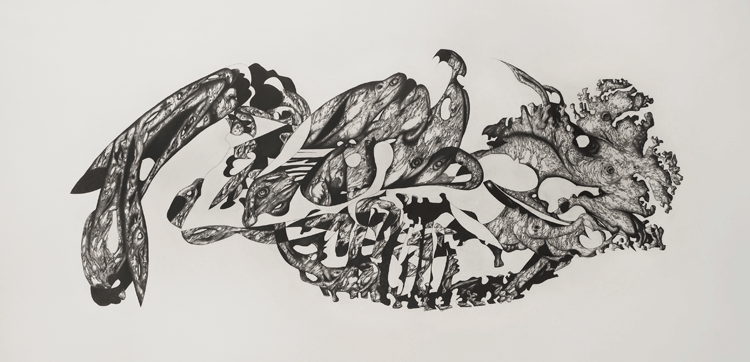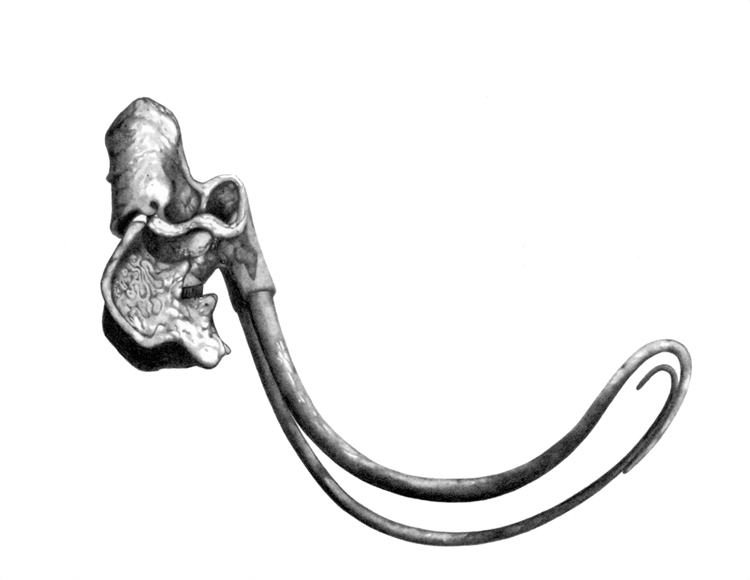 Ultima Thule 40.5” x 83.5” Graphite on Arches 140lb Hot Press Paper Jan 2010 –Aug 2013
Ultima Thule 40.5” x 83.5” Graphite on Arches 140lb Hot Press Paper Jan 2010 –Aug 2013 Often identified as Norway, Greenland or Iceland, “Ultima Thule” is defined as (1) The northernmost region of the habitable world as thought of by ancient geographers., (2) A distant territory or destination., and (3) A remote goal or ideal. The historic “Ultima Thule” is an imaginary place beyond well-travelled borders, the ultimate North, never visited. “Ultima Thule” is not real.
Answers to the two most often asked questions about the drawing “Ultima Thule”: (1) Yes, it’s pencil and (2) I worked on it for 3 ½ years (approximately 2,800 hours).
I work with 2H and 2B graphite leads using a mechanical lead holder, the lead points sharpened to perfection, on Arches 140 pound hot press (smooth) water color paper stretched tight on plywood. I try never to erase. I don’t smudge or smear or blend. I can cover a 2-3” area in 4 hours. I go through a lot of lead pointers. Staedtler in Germany makes the lead pointers, but say they’re no longer designed to sharpen perfectly over the long haul, so I buy in bulk.
I know. 3 ½ years seems like a long time to work on one drawing. Compared to Rodin Crater, Sagrada Família or Carlsbad’s stalactites, of course, 3 ½ years is nothing. If I could work more quickly, I could. But I can’t. Dog sled vs. Concorde. I struggle with this, but I am trying to accept my limitations. Limitations shape/create the work as much as anything.
“Ultima Thule” is a drawing born from the hypothesis that the images I had been creating/ assembling in a series of drawings from 2009, “Lapides Sui Generis,” would work at a larger scale – that those tablet-sized images would scale up in an interesting/impactful way. That series was an extension of drawings inspired by fossil skulls at the American Museum of Natural History in New York and two month-long residencies (one official, one not) at Joshua Tree National Park in California.

Why “Lapides Sui Generis?” In 1677, Robert Plot, the English naturalist, first Professor of Chemistry at the University of Oxford, and first keeper of the Ashmolean Museum, referred to fossils as “Lapides Sui Generis,” which means “stones unto themselves.” Plot’s belief was that fossils were not the remains of once-living organisms, but stones naturally produced by some extraordinary “plastic virtue” directed by God to decorate the inner parts of the earth in the same way flowers beautify its surface. Simon Winchester’s “The Map that Changed the World” tells the story of William Smith, a canal builder whom many consider the founder of modern geology, and his map of England, Wales and parts of Scotland. Smith spent over 20 years following fossils and rock patterns to develop the first true geographical map in history. A work of art in and of itself, Smith’s map measured eight feet high and six feet wide. He had a hard time of it, victimized by plagiarists, indebted and finally bankrupt. Never figured out how to monetize his investment (sounds familiar). But Smith’s achievement was ultimately recognized; today a crater on Mars bears his name.
Prehistoric fossils, monzogranite rock piles – the aesthetics of certain forms, as well as the history and promise of discovery embodied by them – these things appeal to me. I make drawings and paintings in response, basing images on drawn tracing paper overlays and recombinations of natural forms, inventing missing detail, marrying imagination and observation, discovering the abstract within the specific. My work has, over time, moved from the specific/representational to the specific/abstract.
The painter Rackstraw Downes said, “I spend hours … looking at real things with as much concentration as I can muster and everything comes from that concentration.” I love that. My work begins with the same sort of precise/attentive looking/documentation, then grafts on imagination, to create what is, for me, a stronger tree. One from column A and one from column B.
R. Buckminster Fuller said, “When I am working on a problem I never think about beauty. I only think about how to solve the problem. But when I have finished, if the solution is not beautiful, I know it is wrong.” I love that too.
The second and third most often asked questions about “Ultima Thule” (variations of the same question really): “What is it?” and “What’s it about?” The first is easily answered, the second less so.
What “Ultima Thule” is is a drawing (technically true, wholly unsatisfactory/smartass answer). That’s if I’m tired of telling the story or want to shut down the conversation.
If the viewer wants to know what the drawing represents, well, it’s an abstraction. I can tell them about the elements cobbled together to make the image (desert landscape, fossil skulls/bones, maps of Greenland, etc.). I can tell them about my method. Or we can talk about associations the drawing conjures up – alien biology, cartography, bones, fossils, fish eyes, bark/wood grain, geology, sexual organs, etc. (list in formation). And, while this is interesting/entertaining in an exquisite corpse kind of way, I don’t think this is what viewers are really after.
Flannery O’Connor once said that a good story must constitute a tightly-knit organic whole, where meaning and form are inseparably intertwined. When students would write O’Connor and ask that she explain the “meaning” of one of her stories, she would reply: “If I could tell you the meaning, I wouldn’t have written the story.” I know exactly what she means.

People want to know: “What is it about?” Or, “What does it mean?” I haven’t always felt that this was a fair/legitimate question. Shouldn’t the work stand or fall on it’s own terms? Isn’t “meaning” a Chimera specific to and born from the encounter between artwork and viewer, always changing? Maybe. But there are shades of gray. And it’s an honest question. So let me try and answer.
“Ultima Thule” is about the challenge of trying something new. It’s about time, time spent drawing, the collapsibility of time in the studio, the frustrating finitude of time. It’s about travel fever, the end of the road, the traverse, the inch and a half just past the edge of the map (“Here Be Dragons”). It’s about the love of work. It’s about repetition and improvisation. It’s sympathetically resonant with natural history museums, deserts, exploration/explorers, Apollo 11, messages in bottles, icebergs, time capsules, Katie Paterson bouncing Beethoven off the moon, Carl Akeley’s African Hall, boxes full of narwhal ear bones, William Beebe’s bathysphere, basements full of walrus skulls, Peary’s race to the North Pole, chipping away at paleontological matrix with dental tools, Norway, Iceland, and Svalbard, Roosevelt, Emerson and Melville, Roy Chapman Andrews, “Trollhunter,” Gendron Jensen, National Geographic, The Drawing Center, The Explorer’s Club, Big Sur, gravel roads in Baja, Jesse Sykes, Agnes Martin’s writing, Laura Veirs, an ageing Paul McCartney, Julianne Swartz’s “Somewhere Harmony,” and golden records on Voyager spacecraft.
It’s about an unconscious attraction to this form vs. that form. It’s making it up as you go along, it’s stripped down jazz (no tambourines or egg shakers). It’s about a form-shaping set of self-imposed limitations. It’s about what seems “right” to me and “finished” to me and “perfect” to me, and the inevitability of failure in a hopeless/irresistible attempt to pin down the perfect specimen. (It’s also about collecting.) It’s about limitations and endurance and obsessions and heroism.
It’s about stories. Not a “retelling/representation” of stories, not an illustration, but a transmission of the impact/meaning of stories and the experience of ingesting/digesting/reprocessing stories – a patina, a whiff, a brief after-image in graphite. It’s about getting “out there,” it’s about disappearing into the wilderness, it’s about longing. “Ultima Thule” is a journey, “Ultima Thule” is a recording. “Ultima Thule” is real.
Jeff Hoppa, September 2013
Jeff Hoppa’s ULTIMA THULE and other works will be on exhibit at Lawton Mull from Friday September 27, 2013 through Friday, October 4th. Please contact us for hours or to schedule an appointment.

